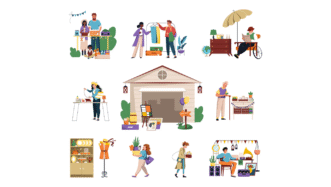LESSON OVERVIEW
In this lesson about free time, students talk about the things they find stressful and what they do to relax. They also watch a video about an unusual pastime activity.
B1 / Intermediate45 min
60 minSpeaking ClassUnlimited Plan
This is a Speaking Class worksheet. It includes a variety of tasks that let your students practise their speaking skills. This lesson format does not focus on grammar or vocabulary. Learn more about it here.
WARM-UP & VIDEO
At the beginning of this lesson about free time, students look at four photos and talk about how the people might feel and why. They need to use some adjectives like cheerful or stressed. Then, students look at a list of things that can make people stressed or relaxed (e.g. music, physical exercise, smartphones) and have to think of particular situations which make people feel that way. Next, students imagine they have a day off and need to choose one activity, in each of five pairs, that they would choose to do. The activities include going for a walk, reading an article and meeting friends. The tasks students do in this part of the lesson about free time allow them to practise their speaking fluency.
Before watching the video, students look at four words and try to guess how the person in the video relaxes. They watch the video to see if they were right. After the video, they need to discuss several questions related to free time and relaxation.
DISCUSSION
In the last part of this lesson about free time, students read four short texts about unusual activities people do to relax and need to do several tasks related to what they read. For instance, they have to choose an activity which is the most dangerous, one that is the easiest and one which they think is the most expensive. In each of the tasks, students are encouraged to explain why they chose a particular pastime activity. One of the tasks can also be turned into homework. The details are available in the teacher’s version of the worksheet and in the e-lesson plan.
Subscribe to unlock these and many other Standalone lesson lesson plans with the Unlimited planWORKSHEETS














Stone stacking is dangerous and could harm wildlife that’s why it’s illegal in most states: https://catalyst.cm/stories-new/2022/4/12/why-creating-rock-cairns-is-dangerous-and-wildly-illegal
Thanks for the comment. I had no idea it was illegal in some places.
Teachers might choose to discuss with students why the activity can be dangerous. After all, the lesson is aimed at adults and the fact that the activity is illegal in some places and not in others makes it an interesting talking point.
Thats a good point, didn’t think about that as it is so beautiful and peaceful. Good that has been taken into account. Shame that hunting can’t also be illegal too…
Oh I love Jonna Jinton 🙂 thanks for choosing her video 🙂 great lesson
Thanks, I like the video too 🙂
nice lesson
I’m glad you like like it 🙂
I like this lesson, the only issue I have is that the video contains some English mistakes and I don’t really like giving my students material with mistakes!
Beautiful video though
Hi, Eleanor. Thanks for the comments 🙂
Sure, the speaker makes some mistakes. But I believe it can be empowering for students to know that she created this beautiful video (which currently has 22 million views) in spite of the fact that her English is not mistake-free. The takeaway could be: My English might not be perfect but that doesn’t mean that I can’t go out there and use it!
I also tell my students that people make mistakes even when speaking their first language. Speakers in other videos make mistakes, too, but we don’t think of them as such – we dismiss them as ‘slips of the tongue’ because it ‘sounds like’ their first language is English.
I would also encourage any teacher to use this opportunity and ask students to listen for mistakes and correct them (if they are not beyond their level).
You could tell your students to try to find the mistakes.
Good lesson, but more B1/ B2 than A2/ B1.
Thanks, Andrew. I’d say the lesson is OK for A2 students, too, but I also think that the perception of language proficiency levels often varies depending on the teacher’s experience, the materials they use or the school’s curriculum. What we try to do is keep the levels consistent across our lessons so that our users always know what to expect.